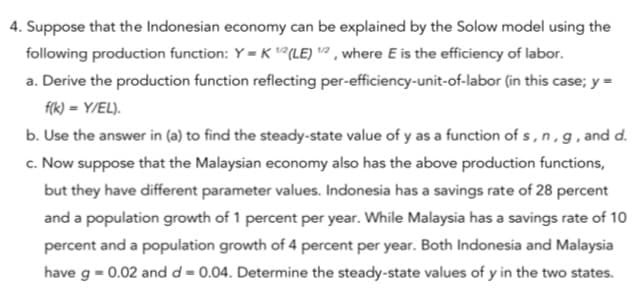1. Suppose that the Indonesian economy can be explained by the Solow model using the following production function: Y = K (LE) ² , where E is the efficiency of labor. a. Derive the production function reflecting per-efficiency-unit-of-labor (in this case; y = fik) = Y/EL). b. Use the answer in (a) to find the steady-state value of y as a function of s, n, g, and d. c. Now suppose that the Malaysian economy also has the above production functions, but they have different parameter values. Indonesia has a savings rate of 28 percent and a population growth of 1 percent per year. While Malaysia has a savings rate of 10 percent and a population growth of 4 percent per year. Both Indonesia and Malaysia have g = 0.02 and d = 0.04. Determine the steady-state values of y in the two states.
1. Suppose that the Indonesian economy can be explained by the Solow model using the following production function: Y = K (LE) ² , where E is the efficiency of labor. a. Derive the production function reflecting per-efficiency-unit-of-labor (in this case; y = fik) = Y/EL). b. Use the answer in (a) to find the steady-state value of y as a function of s, n, g, and d. c. Now suppose that the Malaysian economy also has the above production functions, but they have different parameter values. Indonesia has a savings rate of 28 percent and a population growth of 1 percent per year. While Malaysia has a savings rate of 10 percent and a population growth of 4 percent per year. Both Indonesia and Malaysia have g = 0.02 and d = 0.04. Determine the steady-state values of y in the two states.
Chapter1: Making Economics Decisions
Section: Chapter Questions
Problem 1QTC
Related questions
Question

Transcribed Image Text:4. Suppose that the Indonesian economy can be explained by the Solow model using the
following production function: Y = K (LE) ² , where E is the efficiency of labor.
a. Derive the production function reflecting per-efficiency-unit-of-labor (in this case; y =
fik) = Y/EL).
b. Use the answer in (a) to find the steady-state value of y as a function of s, n , g, and d.
c. Now suppose that the Malaysian economy also has the above production functions,
but they have different parameter values. Indonesia has a savings rate of 28 percent
and a population growth of 1 percent per year. While Malaysia has a savings rate of 10
percent and a population growth of 4 percent per year. Both Indonesia and Malaysia
have g = 0.02 and d = 0.04. Determine the steady-state values of y in the two states.
Expert Solution
This question has been solved!
Explore an expertly crafted, step-by-step solution for a thorough understanding of key concepts.
This is a popular solution!
Trending now
This is a popular solution!
Step by step
Solved in 2 steps with 2 images

Recommended textbooks for you


Principles of Economics (12th Edition)
Economics
ISBN:
9780134078779
Author:
Karl E. Case, Ray C. Fair, Sharon E. Oster
Publisher:
PEARSON

Engineering Economy (17th Edition)
Economics
ISBN:
9780134870069
Author:
William G. Sullivan, Elin M. Wicks, C. Patrick Koelling
Publisher:
PEARSON


Principles of Economics (12th Edition)
Economics
ISBN:
9780134078779
Author:
Karl E. Case, Ray C. Fair, Sharon E. Oster
Publisher:
PEARSON

Engineering Economy (17th Edition)
Economics
ISBN:
9780134870069
Author:
William G. Sullivan, Elin M. Wicks, C. Patrick Koelling
Publisher:
PEARSON

Principles of Economics (MindTap Course List)
Economics
ISBN:
9781305585126
Author:
N. Gregory Mankiw
Publisher:
Cengage Learning

Managerial Economics: A Problem Solving Approach
Economics
ISBN:
9781337106665
Author:
Luke M. Froeb, Brian T. McCann, Michael R. Ward, Mike Shor
Publisher:
Cengage Learning

Managerial Economics & Business Strategy (Mcgraw-…
Economics
ISBN:
9781259290619
Author:
Michael Baye, Jeff Prince
Publisher:
McGraw-Hill Education